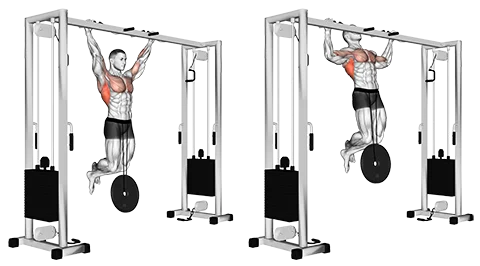Introduction
The Weighted Pull Up is a strength training exercise that involves performing a traditional pull-up while using additional weight. It primarily strengthens the back, biceps, and forearms, improving upper body strength and endurance. This exercise is particularly beneficial for individuals aiming to increase muscle mass in their upper body and enhance their functional fitness. The use of extra weight makes it more effective in achieving specific fitness goals compared to regular pull-ups.
Muscles Worked
- Primary: Latissimus Dorsi, Biceps Brachii, Back (Rhomboids, Middle Trapezius, Teres Major)
- Secondary: Forearm (Brachioradialis), Shoulder (Deltoids), Core (Rectus Abdominis, Obliques)
How to Do It (Step-by-Step)
- Stand under a pull-up bar with a weighted belt or vest around your waist, feet shoulder-width apart on the floor.
- Grab the pull-up bar using an overhand grip (palms facing away from you), arms fully extended but not locked.
- Keep your core engaged, shoulders down, and avoid swinging or jerking. Lower your body until your chest almost touches the bar, then use your back muscles to pull yourself up until your chin is above the bar. Avoid using momentum; focus on controlled movements.
Tip: Start with a weight that allows you to complete 3-5 reps in good form. Gradually increase the weight as you improve your strength and technique.
Rep & Rest Guidelines
- Strength: 4–6 reps, 2–3 min rest
- Hypertrophy: 8–12 reps, 60–90 sec rest
- Endurance: 12–20 reps, 30–60 sec rest
For optimal weighted pull up progression, consider Auto Progression in your training plan.
Stay consistent with rest periods using the Rest Timer feature.
Form Tips
- Maintain a straight back: Keep your body in a straight line from heels to head, engaging your core muscles. Avoid arching or rounding your back.
- Grip the bar correctly: Use an overhand grip with your hands shoulder-width apart. A pronated (palms facing forward) grip is generally used for weighted pull-ups.
- Utilize a full range of motion: Pull your chin above the bar, pause briefly at the top, and lower yourself slowly until your arms are fully extended. This ensures you're working the muscles properly and helps prevent injury.
When to Use It
- Building Upper Body Strength: Weighted pull ups help increase overall upper body strength, particularly focusing on the back, shoulders, and biceps.
- Athletic Performance Enhancement: Incorporating weighted pull ups into training can improve explosive power and vertical jump height for various sports.
- Muscle Hypertrophy Development: For those aiming to build muscle mass, weighted pull ups are an effective exercise to target the latissimus dorsi and other back muscles.
Workout History can help you track your progress in these scenarios and many more.
Weighted pull ups primarily work the back, shoulders and biceps.
Grip the bar with your hands shoulder-width apart, pull yourself up while keeping your body straight, lower yourself back down slowly, and repeat.
Start with a weight that allows you to do 3 sets of 8 reps with good form. Adjust the weight as needed based on your progress.
Using a belt for support can help maintain proper form, but aim to build enough strength to perform unassisted pull ups eventually.
3-4 sets of 8-12 reps per set is a good starting point. Adjust based on your progress and fitness goals.

